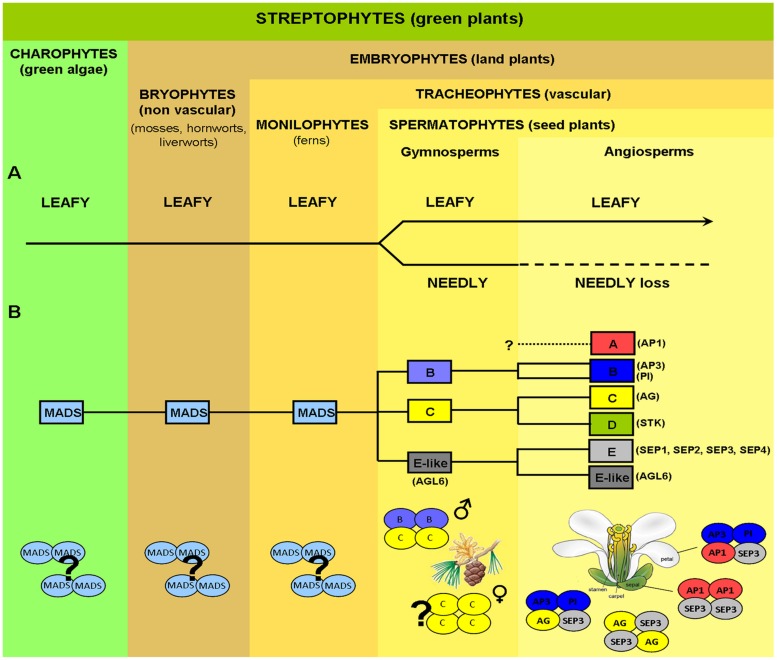FIGURE 1.
Evolution of key genes controlling plant reproductive development. (A) Evolution of LEAFY (LFY) from green algae to angiosperms. LFY exists mostly as a single-copy gene in all streptophytes (green plants), with the exception of gymnosperms where a LFY-like paralog, NEEDLY (NLY), originated after a major duplication event (the only possible exception being the genus Gnetum). In gymnosperms, LFY and NLY are consistently expressed in both male (pollen-bearing) and female (seed-bearing) cones, in a spatiotemporal coordinated manner. In the angiosperm lineage, NLY was subsequently lost, with LFY now regulating the expression of genes responsible for both the male and female organs in the unified bisexual flower. (B) MADS-box homeotic gene family. MADS-box genes are present in the most simple green algae and, as plants became more complex, the MADS-box gene family expanded via multiple duplication and specification events. Putative orthologs of class B, C, and E-like (AGL6) floral homeotic genes have been isolated from different gymnosperms (conifers, gnetophytes, ginkgophytes, and cycads) as shown schematically by yellow and blue colored ovals. In contrast, SEP-like genes, the second subfamily conferring E-class function, as well as A-class genes, seem to be absent in extant gymnosperms but are present in all angiosperms. In gymnosperms, expression patterns of putative B and C-class gene orthologs resemble those of B and C-class genes in angiosperms, with B-class genes being expressed on male reproductive organs, whereas C-class genes are expressed in both male and female organs. In gymnosperms C-class proteins alone or C and B-class proteins together seem capable of forming tetrameric complexes (without any additional partners), which define, respectively, the female and male organs in these organisms as indicated. In angiosperms tetramer formation is dependent on the SEPALATTA (E-class) TFs which act as hubs by mediating interactions among proteins from different floral homeotic classes, strictly determining floral organ identity. Question marks indicate uncertainty as to physiological oligomerisation state, AP1, APETALA1; AP3, APETALA3; PI, PISTILLATA; AG, AGAMOUS; STK, SEEDSTICK; SEP, SEPALLATA; AGL6, AGAMOUS LIKE 6.

